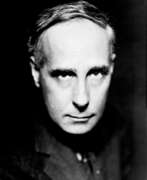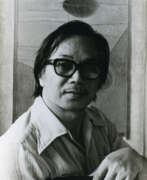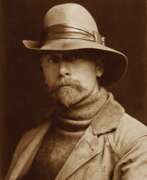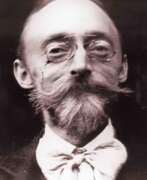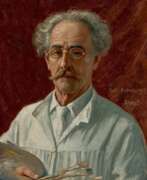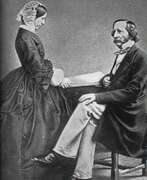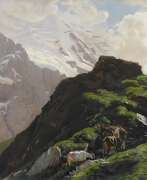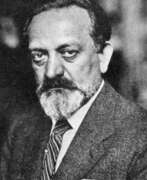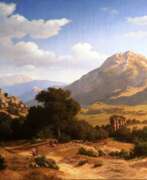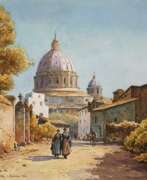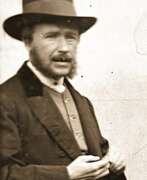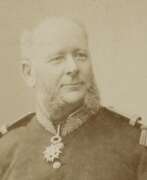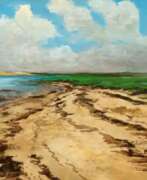Photographers 19th century


Julius Anton Adam was a German genre painter and animalist who specialised in the depiction of cats and was a member of an influential family of Munich painters.
Julius Anton Adam was a pupil of Professor Michael Echter and later Wilhelm von Dietz at the Munich Academy of Art. He later became a professor himself.


Laure Albin-Guillot was a French artist and photographer. She is best known for her pioneering work in photography and for her contributions to the development of the medium in France during the early 20th century.
Albin-Guillot's early photographic work was focused on portraiture, and she became known for her elegant and striking images of celebrities and other notable figures. She later expanded her practice to include still life and landscape photography, and she was also a skilled photojournalist.
In addition to her photography, Albin-Guillot was an important figure in the Parisian art world, and she was involved in the development of modernist movements such as Cubism and Surrealism. She was a member of the Société des Artistes Décorateurs and was also involved in the organization of several major international exhibitions, including the Exposition Internationale des Arts Décoratifs et Industriels Modernes in Paris in 1925.
Albin-Guillot was also a prolific writer and educator, and she wrote several books on photography and art history. She taught photography at the École Estienne in Paris, and she also founded her own photography studio, which became known for its innovative use of lighting and composition.
Today, Albin-Guillot's work is recognized as an important contribution to the development of modern photography, and her photographs are held in the collections of major museums around the world, including the Museum of Modern Art in New York, the Centre Pompidou in Paris, and the Victoria and Albert Museum in London.


Karl Blossfeldt was a German photographer, sculptor and teacher who worked in Berlin. He was one of the representatives of the New Vision in photography. Blossfeldt worked with a camera of his own invention that allowed him to reach a 30x magnification.
He photographed mainly flowers, plants and plant fragments. Under this magnification plants resemble abstract shapes rather than the plant itself. Blossfeldt's photographs can be equally classified as scientific photography and as works of art.


Jósef Borsos is a Hungarian portrait painter and photographer.
Borsos studied art at the Academy of Fine Arts in Vienna. He painted portraits of historical figures, but became best known for his genre paintings in the Biedermeier style.


Constantin Brâncuși was a Romanian sculptor, painter, and photographer who made his career mainly in France, becoming one of the pivotal figures of modern sculpture and a pioneer of modernism. Born in 1876 in Hobița, Romania, Brâncuși displayed a talent for carving from a young age, a skill honed during his early life as a shepherd in the Carpathian Mountains. His work evolved from traditional forms to groundbreaking abstract sculptures that sought to capture the essence rather than the literal representation of his subjects.
After moving to Paris in 1904, Brâncuși's unique style began to take shape. He worked briefly in the studio of Auguste Rodin, but soon left to pursue his own vision, stating that "Nothing can grow under big trees." This decision marked the beginning of his pursuit to distill forms to their simplest essence, a philosophy that would define his career. Brâncuși's sculptures, such as "The Kiss" and "Bird in Space," are celebrated for their smooth, simplified forms that evoke the core of the subject matter with minimal detail. His work in wood, bronze, and marble often carried a serene, timeless quality, blending modernist aesthetics with a touch of his Romanian heritage.
Brâncuși's contributions to art were not limited to sculpture. He was also an accomplished photographer, using his camera to capture the spatial relationships and compositions of his studio and sculptures, an extension of his artistic vision. His works are held in high regard worldwide and are featured in prominent collections, such as the Museum of Modern Art in New York and the Tate in the United Kingdom.
The legal battle over "Bird in Space" in 1927 highlighted the challenges Brâncuși faced in having his work recognized as art by traditional standards. This case, which eventually ruled in his favor, established a precedent for modern art's recognition beyond traditional forms and representations.
For art collectors and experts, Brâncuși's oeuvre represents a bridge between the tactile craftsmanship of earlier periods and the conceptual, form-driven concerns of modern art. His legacy is a testament to the power of innovation, vision, and the enduring appeal of simplicity in form.
For those interested in the evolution of sculpture and the role of art in transcending cultural and temporal boundaries, Constantin Brâncuși's work offers profound insights. We invite you to sign up for updates on new product sales and auction events related to Brâncuși's work, ensuring you stay informed about opportunities to engage with the legacy of this pioneering artist.


George Hendrik Breitner was a Dutch painter and photographer. An important figure in Amsterdam Impressionism, he is noted especially for his paintings of street scenes and harbours in a realistic style. He painted en plein air, and became interested in photography as a means of documenting street life and atmospheric effects — rainy weather in particular — as reference materials for his paintings.




Louis Buvelot, born Abram-Louis Buvelot, was a Swiss landscape painter who lived 17 years in Brazil and following 5 years back in Switzerland stayed 23 years in Australia, where he influenced the Heidelberg School of painters. Buvelot is best known for his great contribution to Australian art. His works, mostly oil landscapes, are quite well regarded, but perhaps his impact was even greater as a tutor of several members of the Heidelberg School. His enthusiasm for plein air painting (that is, painting directly in the open air) was a key characteristic of those artists' work.


Alvin Langdon Coburn was an American photographer and artist who was best known for his pioneering work in the field of pictorial photography. He was a member of the Photo-Secession movement, which was a group of photographers who sought to elevate photography to the status of fine art.
Coburn was born in Boston, Massachusetts, and grew up in England. He began taking photographs when he was just eight years old and later studied photography in New York City. He went on to become one of the leading photographers of his time, and his work was exhibited widely in Europe and the United States.
Coburn is perhaps best known for his innovative use of the "vortograph," a technique he developed in 1917 that involved photographing objects through a triangular arrangement of mirrors. The resulting images were highly abstract and geometric, and anticipated the work of many later artists, including the Surrealists.
In addition to his work in photography, Coburn was also an accomplished painter and printmaker. He continued to work as an artist throughout his life, and his work is now held in the collections of many major museums around the world.


Imogen Cunningham was an American photographer known for her botanical photography, nudes, and industrial landscapes. Cunningham was a member of the California-based Group f/64, known for its dedication to the sharp-focus rendition of simple subjects.
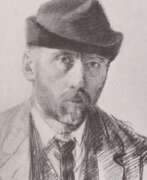

Frans Deutman was a Dutch painter. He graduated from the Antwerp Academy of Arts, a pupil of Charles Verlat. He belonged to the Laren School of painting, a direct continuation of the Hague School.
Frans Deutman is known for his portraits and figures in interiors.


Lewis Carroll, real name Charles Lutwidge Dodgson, was a British writer and photographer, philosopher and logician, and professor of mathematics.
In 1851 Lewis entered one of the best colleges in Oxford - Christ Church. Showing an extraordinary aptitude for mathematics, soon he was able to give lectures himself, and for the next quarter of a century he was a professor of mathematics at Oxford. In parallel with his studies, the young man began to compose short stories and poems, publishing them under a pseudonym.
And then he wrote the famous "Alice's Adventures in Wonderland" (Alice's Adventures in Wonderland, 1865) and "Alice in Looking-Glass" (Through the Looking-Glass, and What Alice Found There, 1871). These books quickly became popular, they were translated into numerous languages, and then repeatedly screened. The prototype of the main character was four-year-old Alice Liddell, the daughter of the new dean of the college where Carroll taught. Lewis Carroll also wrote "The Knotty Story", a humorous poem "Hunting the Snark", "Mathematical Curiosities", "Sylvia and Bruno" and other books. Carroll himself considered his main work a slightly absurd novel-tale "Sylvia and Bruno" (1889-1893).
Under his real name, the writer-mathematician published scientific works on mathematics and logic, he also owns a number of popular books on entertaining mathematics. Lewis Carroll left Oxford only once - in 1867, visiting Russia as part of a delegation of the Anglican Church on the route St. Petersburg-Moscow-Nizhny Novgorod. This was Carroll's only overseas trip, and he described it in his Diary of a Trip to Russia 1867. Lewis Carroll was also a talented chess player and amateur inventor. Photography was also a big part of the writer's life.


Ivan Osipovich Dudin (Russian: Иван Осипович Дудин) was a Russian and Soviet artist, painter, translator, and educator. He was born on January 19, 1867, in Moscow and passed away on April 4, 1924, in the same city. Dudin received his education at Moscow University and the Moscow School of Painting, Sculpture, and Architecture, where he was awarded the title of class artist in 1902.
Dudin is known for his landscapes, portraits, and genre scenes. His extensive travels influenced his works significantly. Since 1894, he regularly participated in exhibitions of the Moscow Society of Art Lovers and the Association of Traveling Art Exhibitions. Among his notable students were famous artists such as A.V. Kuprin, V.A. Favorsky, and V.I. Mukhina.
One of Dudin's significant works is "Blooming Garden" from 1902, which is exhibited in the State Tretyakov Gallery. His works can also be found in museums in Irkutsk, Kirov, and Krasnodar.
If you want to receive updates on new sales and auction events related to Ivan Osipovich Dudin, sign up for our updates. We will inform you only about new arrivals and events related to this artist.


Thomas Cowperthwait Eakins was a pivotal figure in American realism, celebrated for his profound and uncompromising portrayal of the human figure. Born on July 25, 1844, in Philadelphia, Pennsylvania, Eakins dedicated his life to depicting authentic human experiences and emotions through painting, sculpture, and photography.
Eakins' education in art began at the Pennsylvania Academy of the Fine Arts and extended to studying abroad in Europe, where he was influenced by French realists and the anatomical precision in their work. His approach combined rigorous study of the human form with a realistic portrayal of American life, making significant contributions to both art and educational practices in the United States.
His notable works include "The Gross Clinic" and "Max Schmitt in a Single Scull," which showcase his mastery in combining technical skill with emotional depth. These pieces not only depict scenes from everyday life but also incorporate a level of detail that reveals Eakins' deep respect for the individuality and inner life of his subjects. Despite facing criticism during his lifetime, particularly for his unflinching realism and subjects considered controversial at the time, Eakins was posthumously recognized as one of America's foremost painters.
For those interested in learning more about Thomas Cowperthwait Eakins' life, works, and his impact on American art, visiting collections that feature his work, such as the Metropolitan Museum of Art and the Pennsylvania Academy of the Fine Arts, can offer deeper insights.
To stay updated on exhibitions, new findings, and auction events related to the remarkable works of Thomas Cowperthwait Eakins, consider signing up for our newsletter. Gain exclusive insights and early notifications tailored for collectors and art enthusiasts. This is an excellent opportunity to deepen your appreciation and knowledge of one of America's greatest realist artists. Subscribe today to ensure you don't miss out on these valuable updates!


Johannes Hinderikus Egenberger was a Dutch painter, photographer and art educator. From 1840 to 1848, he studied at the Royal Academy of Fine Arts in Amsterdam with Jan Willem Pieneman. During these years, he focused on painting scenes from Dutch history. In 1854, he collaborated with Barend Wijnveld to produce a massive canvas depicting the heroic defense of Haarlem led by Kenau Hasselaer in 1573. Later, he would turn to landscapes, domestic scenes and portraits, including a series for the Rijksuniversiteit. In 1857, he was appointed Headmaster of the Academie Minerva in Groningen. In addition to his work there, he became a photographer and, in 1864, opened the first photography studio in Groningen. The following year, he resigned his position as Headmaster to devote himself entirely to photography.


Sir John Frederick William Herschel, 1st Baronet was a British astronomer and son of the Uranus discoverer Wilhelm Herschel. He is credited with the first double star and nebula catalogues of the southern starry sky, which he observed during a five-year stay near Cape Town.
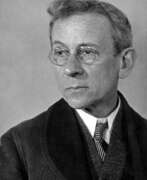

Lewis W. Hine was not an artist in the traditional sense, but rather a photographer and social documentary photographer who used his camera as a tool for social change. He is best known for his work in the early 20th century, documenting the living and working conditions of children in the United States.
Hine's photographs were instrumental in bringing about changes in child labor laws in the United States, and his images were used as evidence in court cases and Congressional hearings. He believed that photography could be a powerful tool for social reform, and he used his camera to highlight the injustices and hardships faced by working-class Americans.
In addition to his work as a photographer, Hine was also a teacher and an advocate for the arts. He taught at the Ethical Culture School in New York City, where he encouraged his students to use photography as a means of social commentary.
Hine's legacy as a photographer and social activist continues to inspire generations of artists and advocates for social justice. His photographs are considered a valuable historical record of life in the early 20th century, and his commitment to using art as a means of social change remains a powerful example of the role that artists can play in shaping society.


Ruth Miriam Hollick was an Australian portrait and fashion photographer who was one of Melbourne's leading Pictorialist photographers during the 1920s. There is evidence that Hollick was experimenting with photography in a home darkroom by 1907. The following year, she set herself up as a freelance photographer who toured rural areas of the state of Victoria, making portraits of families, especially children. She worked mostly outdoors in natural light with a field camera. By World War I, she had shifted into studio photography. It was in this period that Hollick developed a reputation for skillful use of both natural and studio lighting and for stylish compositions, often setting her subjects against plain backgrounds. She specialized in portraits of society figures and celebrities, as well as fashion photography for use in advertisements.


Johann Baptist Isenring was a Swiss landscape painter and printmaker, one of the first photographers in 19th-century Switzerland.
Johann studied painting and aquatint at the Munich Academy of Fine Arts, opened an art studio in St. Gallen in 1828 and soon began publishing his lithographic collection of picturesque views of Switzerland's most remarkable cities and towns.
In 1839, Isenring, fascinated by the discoveries of Niépce and Daguerre, bought equipment for "daguerreotype" and a year later organized an exhibition in his studio in Multtertor, which was probably the first photographic exhibition in the world. Isenring even gave up painting for a while and worked as a photographer for two years, settling in Munich. He made portraits, photographs of architecture, reproductions of paintings and developed a coloring method for his prints, which he patented in America.
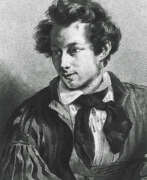



Hermann Krone was a German scientist, traveler, photographer, and publisher. He made his first daguerreotypes in 1843. He had studios in Leipzig and Dresden. In 1872 Krone completed a photobook with views of 142 cities of the Kingdom of Saxony. He also published his poems and scientific works.


Carl Christian Heinrich Kühn was an Austrian–German photographer and photography pioneer.
Heinrich Kühn is regarded one of the forefathers of fine art photography, the movement that helped photography to establish itself as an art on its own. His photographs closely resemble impressionist paintings, with their frequent use of soft lighting and focus. Kühn was part of the pictorialist photographic movement.
Kühn mainly used the gum bichromate technique, applied in several layers, and thus allowing for previously unseen color tonalities.


William Frederick Lake Price was a British painter, watercolorist, lithographer, and one of the first photographers.
Price originally trained as an architect and was an assistant to Augustus Pugin before becoming a watercolorist, photographer, and lithographer. Price knew almost every European language and traveled extensively. The subjects of his paintings were varied, from country house interiors to views of Venice, many are architectural, but there are also literary and historical genre scenes.
From 1828 to 1832 Price exhibited at the Royal Academy, and from 1855 to 1860 he had already exhibited at the Photographic Society of London. In the 1850s he joined the London Photographic Society and the London Photographic Exchange Club. Price staged and directed his first photographs meticulously. He consciously endeavored to elevate the newly emerging photography to the level of "high art," imitating the ambitious literary subjects, expressive gestures, and historical details of great historical painting. In 1858 many of his photographic portraits were published in Portraits of Eminent British Artists.


Rafail Sergeevich Levitsky (Russian: Рафаи́л Сергее́вич Леви́цкий) was a Russian artist of the last third of the 19th century to the first third of the 20th century. He is known as a painter-painter, photographer and teacher, professor of porcelain painting.
Rafail Levitsky painted genre paintings, portraits, landscapes, interiors, battle scenes from life. He is also considered the first artist in history to become a photographer. His many famous photographic portraits replaced models for painters, lithographers, illustrators, and engravers, as in the case of the portrait of Emperor Alexander III, which was reproduced on Russian banknotes.


Gaspard-Félix Tournachon, known by his pen name Nadar, is a French photographer, cartoonist, journalist, writer and balloonist.
Throughout his career, Nadar shot portraits of many famous personalities, including writers, artists, musicians and politicians. Among them were Victor Hugo and Charles Baudelaire, Sarah Bernhardt and George Sand. Nadar's portraits were in great demand as he had a unique ability to reveal the inner essence of his subjects, revealing their character and emotions.
In addition to portraiture, Nadar was an aerial photographer, using hot air balloons to capture breathtaking images from high above. His boldness and adventurous spirit led him to explore new perspectives and techniques, making a significant contribution to the development of aerial photography. In 1858, he became the first person to take aerial photographs.




Titian Ramsay Peale was an American artist, naturalist, and explorer from Philadelphia, Pennsylvania. He was a scientific illustrator whose paintings and drawings of wildlife are known for their beauty and accuracy.
Peale was a member of several high-profile scientific expeditions. In 1819-1820, he and Thomas Say accompanied Stephen Harriman Long on an expedition to the Rocky Mountains. He was also a member of the United States Exploring Expedition (1838-1842).
Starting around 1855 Peale became an enthusiastic amateur photographer. Many of his photographs featured buildings and landscapes in and around Washington D.C. He joined a local club with other amateur photographers and participated in field trips, photo exchanges and contests. By the end of the Civil War, his interest in photography waned and he only occasionally took pictures.


Konstantin Konstantinovich Pervukhin (Russian: Константи́н Константи́нович Перву́хин) was a Russian artist of Ukrainian origin of the late 19th and early 20th centuries. He is known as an impressionist landscape painter, illustrator, and photographer.
Konstantin Pervukhin is considered one of the greatest Russian artists of the turn of the century, continuing the traditions of the Russian landscape school. His work reflected many of the trends characteristic of the art of the time. At the height of his career, the artist used many impressionistic techniques in painting: he painted in a free manner, paying particular attention to the transfer of light and air environment and the changing states of nature.
Pervukhin was a Wanderer and one of the founders of the Union of Russian Artists.


Lavr Kuzmich Plakhov (Russian: Лавр Кузьмич Плахов) was a Russian artist of the mid-19th century. He is known as a painter, lithographer and photographer, one of the most prominent representatives of the Venetian school.
Lavr Plakhov became famous as a master of genre painting. In his thematic paintings the central place was taken by the image of the people of labor. At the peak of his career, the artist abandoned painting and engaged in art photography.


Eugène Pluchart (Russian: Евгений Александрович Плюшар) was a Russian painter and photographer of French descent, born in 1809 in Saint Petersburg and passed away around 1880 in Dresden. Initially trained at the Beaux-Arts de Paris under Louis Hersent, he further honed his skills at the Academy of Fine Arts in Munich. Pluchart's artistry blossomed during a study trip to Italy, which significantly influenced his style.
Pluchart is renowned for his portrait work and frescoes, notably contributing to the décor at Saint Isaac's Cathedral during the 1840s. His mastery in capturing the essence of his subjects is evident in his portraits of notable figures such as the composer Karol Lipiński, which earned him the title of full Academician by the Imperial Academy of Arts. His works also include a notable portrait of the composer that further solidified his reputation.
After a prolific period in Russia, Pluchart moved to Dresden in the early 1860s. His later years were quieter, with his contributions to the arts remaining influential, particularly in Russia and Germany. His works are part of the collection in prominent institutions like the Hermitage Museum and the Alte Nationalgalerie.
For those interested in the works and life of Eugène Pluchart and future auction events related to his art, consider subscribing to updates [insert link here]. This subscription will keep you informed about new product sales and auction events specifically related to Eugène Pluchart, ensuring you stay connected to the latest offerings in his artistic legacy.
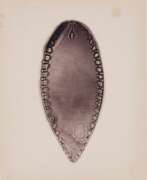

John Thomas Redmayne was a British surgeon, physician and amateur naturalist.
Redmayne trained as a physician and surgeon in Glasgow, then received his diploma at Guy's Hospital in London and was licensed by the Royal College of Physicians in Edinburgh.
In addition to being a physician, J. Redmayne was an amateur naturalist, he became interested in microscopy and specialized in diatom algae. He is considered one of the most successful microphotographers of the time, and his founding of the Bolton Microscopical Society allowed him to concentrate on the study of diatoms. His microscopic diatom plates were highly respected, particularly for the relative purity of the species. He also mounted histological preparations. Redmayne gave copies of his book to the Quekett Microscopical Club (which he joined in 1876) and the Royal Microscopical Society.


Paul Regnard, full name Paul Marie Léon Regnard, was a French physician, physiologist and photographer, and teacher.
He became a trainee at the hospital in 1874 and received his MD degree in 1878. Paul Regnard was deputy director of the Hautes Etudes Laboratories, and from 1878 taught general physiology at the newly founded National Agronomic Institute and later became its director (1902). He was also from 1895 a member of the Academy of Medicine in the section of biological sciences.
Regnard was one of the first practitioners of medical photography, particularly photographs of the mentally ill. Together with Désiré-Magloire Borneville, he directed the photographic service at the Salpêtrière Hospital of Paris, established by the psychiatrist J.C. Charcot (1825-1893). Numerous photographs were published in the book Iconographie Photographyique de la Salpêtrière. Regnard was a tireless researcher. He was one of the first naturalists to study the effects of atmospheric pressure on microbial metabolism. The scientist made a detailed historical and bibliographical survey of descriptions of possession and witchcraft through the ages, focusing on well-documented cases.
Regnar was particularly interested in the physical manifestations described by contemporaries: fainting spells, tetany, paresthesias, signs that could only be interpreted as diabolical or at least miraculous. All these signs Regnard had already observed, photographed, and treated at the Salpêtrière Hospital in the department of J.M. Charcot, to whom he dedicated this work, and so it was from the perspective of nascent psychiatry that Regnard analyzed these historical cases.
For his services, Regnard was made a Chevalier of the Legion of Honor in 1884, then an officer in 1900.


August Sander was a German portrait and documentary photographer. Sander's first book Face of our Time (German: Antlitz der Zeit) was published in 1929. Sander has been described as "the most important German portrait photographer of the early twentieth century".


Ferdinand Schmutzer, a distinguished Austrian printmaker, photographer, and portrait painter, hailed from a rich artistic heritage in Vienna. With his great-grandfather, Jacob Matthias Schmutzer, having founded the esteemed "k.k. Kupferstecher-Academie," creativity ran deep in his family. Following in the footsteps of his grandfather and father, Ferdinand initially explored sculpture but later honed his skills in painting at the renowned Vienna Academy. A transformative study trip to the Netherlands sparked his fascination with etchings, inspired by the works of Rembrandt van Rijn. Soon, his exquisite portraits of Vienna's elite garnered widespread acclaim, with prominent figures like Sigmund Freud, Albert Einstein, Kaiser Franz Josef, the Vienna Philharmonic, and Karl Lueger posing for him.
Notably, Schmutzer's art transcended borders, as he exhibited internationally and received numerous awards and accolades. Pioneering the use of larger formats in etching, he pushed the boundaries of the art form, bringing innovation to the technique. Becoming a member of the Vienna Secession in 1901 and later a professor at the Academy of Fine Arts Vienna in 1908, Schmutzer's impact on the art world was undeniable. His legacy lives on, inspiring future generations of artists, and he remains an iconic figure in Austrian art history.


Edward Steichen was a Luxembourgish American photographer, painter, and curator, renowned as one of the most prolific and influential figures in the history of photography.
Steichen was credited with transforming photography into an art form. His photographs appeared in Alfred Stieglitz's groundbreaking magazine Camera Work more often than anyone else during its publication run from 1903 to 1917. Stieglitz hailed him as "the greatest photographer that ever lived".


Alfred Stieglitz was an American photographer and modern art promoter who was instrumental over his 50-year career in making photography an accepted art form. In addition to his photography, Stieglitz was known for the New York art galleries that he ran in the early part of the 20th century, where he introduced many avant-garde European artists to the U.S. He was married to painter Georgia O'Keeffe.


Mickalene Thomas is a contemporary African-American visual artist best known as a painter of complex works using rhinestones, acrylic, and enamel. Thomas's collage work is inspired from popular art histories and movements, including Impressionism, Cubism, Dada and the Harlem Renaissance. Her work draws from Western art history, pop art and visual culture to examine ideas around femininity, beauty, race, sexuality, and gender.


Henry Scott Tuke was an English visual artist; primarily a painter, but also a photographer. His most notable work was in the Impressionist style, and he is best known for his paintings of nude boys and young men.
Trained at the Slade School of Art under Alphonse Legros and Sir Edward Poynter, Tuke developed a close relationship with the Newlyn School of painters, his work being exhibited at the Royal Academy of Arts, of which he became a Full Member. In addition to his achievements as a figurative painter, he was an established maritime artist and produced many portraits of sailing ships. He was highly prolific, with over 1,300 works listed and more being discovered.


Baron Wilhelm Ivan Friederich August von Gloeden, commonly known as Baron von Gloeden, was a German photographer who lived and worked in Italy. One of the greatest masters of male nudity, a precursor of homosexual photography and a forerunner of performance art.
Wilhelm von Gloeden is mainly known for his pastoral photographs of nude Sicilian boys, which usually feature props such as wreaths or amphorae, suggestive of ancient Greece or Italy. From a contemporary perspective, his work is commendable for its controlled use of lighting, as well as the often elegant poses of his models. His innovations include the use of photofilters and special cosmetics (a mixture of milk, olive oil and glycerine) to mask skin imperfections.
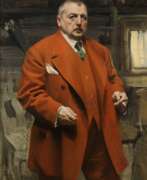

Anders Leonard Zorn was a Swedish painter, graphic artist, photographer and sculptor.
Zorn studied at the Stockholm Academy and then traveled extensively throughout Europe. After working in England, France and the United States, he returned to Mora in 1896. Zorn painted landscapes and portraits in watercolor and oil, and became known mainly for original salon painting and secular portraiture. Among his models were King Oscar II of Sweden, U.S. Presidents Grover Cleveland, William Taft, and Theodore Roosevelt. Through his work, Anders Zorn gained a reputation as one of the best genre painters and portraitists in Europe at the end of the 19th century, whose talent lay in his perceptive ability to convey the individual character of the model. At the age of 29, he was awarded the title of Chevalier of the Legion of Honor at the 1889 Universal Exposition in Paris.
Zorn also worked in etching, using the technique of drawing parallel lines across the plate; he was also a sculptor. Anders Zorn also amassed a significant art collection, which he bequeathed to the Swedish state. At the end of his life in 1920, he established the Swedish Bellman Prize for Literature.














